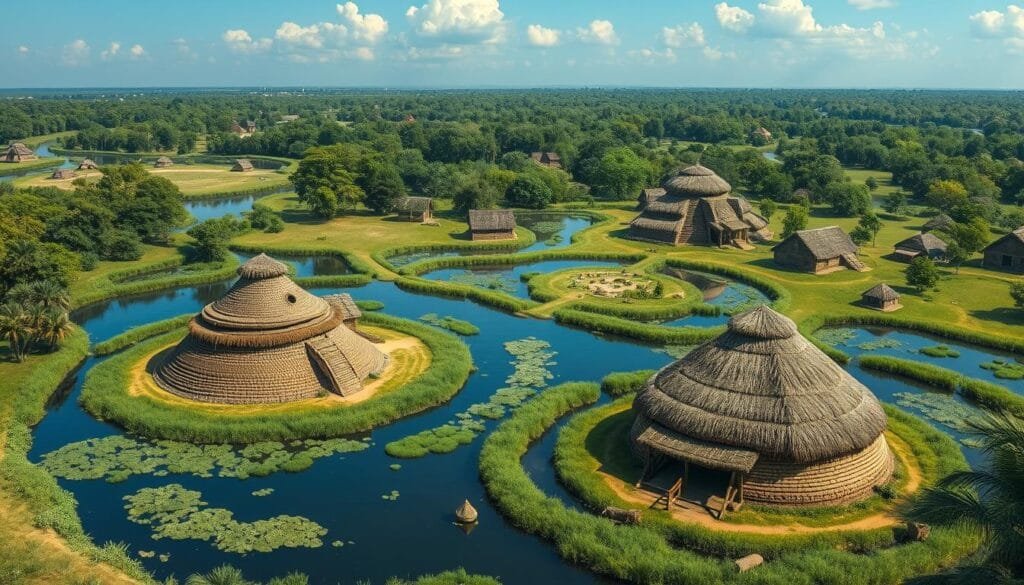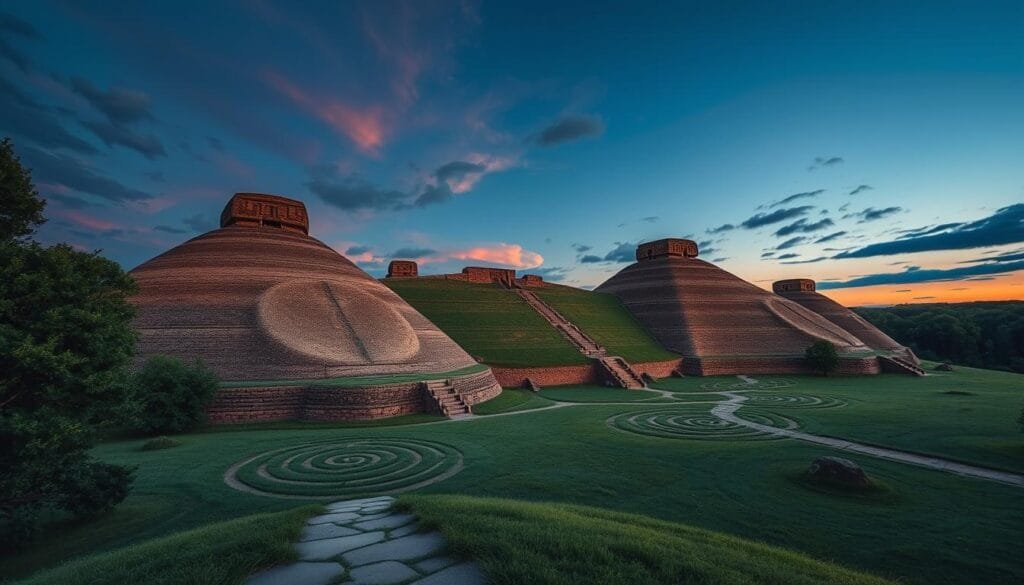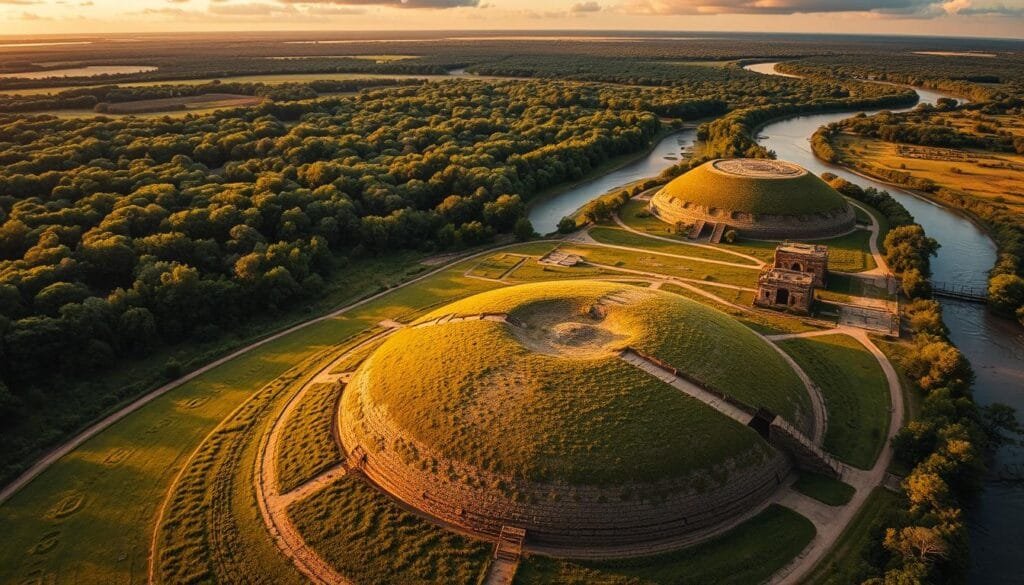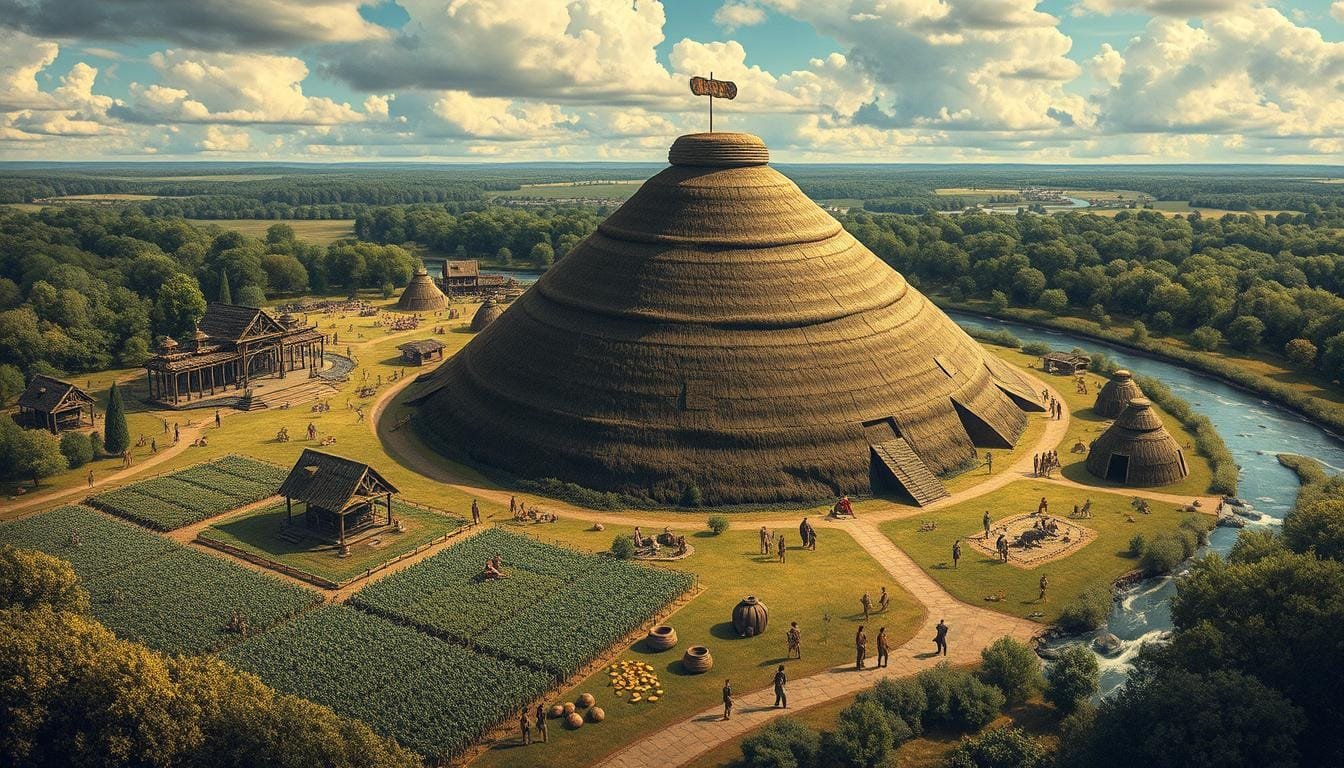Ever wondered about the ancient Native American societies? They thrived with detailed city designs and defensive structures. The Mississippian culture reveals a world where moats were essential, showing their strategy in creating complex societies.
The phrase “Mississippian culture” describes interconnected native groups alive from about 800 to 1600 AD. They lived throughout the Midwest, East, and Southeast United States. Their trade networks and ceremonial centers were advanced. For instance, Cahokia in today’s Illinois was a key religious hub with a vast population.
Moats were vital for some Mississippian sites in North America, adding to their urban and architectural skills. For example, Georgia’s Etowah Mounds, a major South Appalachian site, had moats and wooden fences for defense and marking community boundaries. These features show the Mississippian culture’s influence on ancient Native American architectural styles.
Key Takeaways
- The Mississippian culture emerged around 800 AD and flourished until approximately 1600 AD.
- These societies were marked by significant social and political complexity, evident in sites like Cahokia.
- Moats were part of the defensive structures in some Mississippian sites, showcasing their advanced urban planning.
- The historical significance of Mississippian culture is profound, influencing the later development of Native American societies.
- Trade networks and ceremonial complexes were central to the thriving of these ancient communities.
Intrigued by ancient defenses and want to dive deeper into the Etowah Mounds? Learn about their cultural significance in this detailed exploration on the Etowah Mounds.
Introduction to the Mississippian Culture
The Mississippian culture began in the Mississippi River Valley. It was a key period in North American prehistory from 600 to 1500 A.D. The fertile river environment helped its growth. This was because it was good for growing crops. Maize was very important for them, supporting big cities like Cahokia and Etowah.
Experts believe this culture started around 800 AD. It peaked by 1200 AD but started to fall by 1400 AD. This was due to nature and European contact. Big, crowded cities popped up during this time. Places like Cahokia had huge mounds and special areas for ceremonies. Etowah was known for its strong defenses, like a moat and wooden walls.
The Mississippian culture varied significantly across regions. Cahokia, for example, was a big city with many mounds. Nearby, the Toltec Mounds in Arkansas had a big wall around its eighteen mounds. Spiro was a key trading spot between 1100 and 1350 CE, with mounds laid out according to the sun. Meanwhile, the Parkin Site was designed for defense, with a moat on three sides.
| Key Site | Notable Features | Timeline |
|---|---|---|
| Cahokia | Extensive mounds, major urban center | Peak around 1200 AD |
| Etowah | 61-feet high mound, defensive structures | 1200-1375 AD |
| Toltec Mounds | Mile-long earthen embankment, 18 mounds | Pre-1300 AD |
| Spiro | Trade center, aligned mounds | 1100-1350 CE |
| Parkin | Moat on three sides, strategic location | Post-European contact |
Different places adapted to their environments in various ways. Yet, they all shared common practices like mound-building and growing maize. These shared traditions highlight how complex and adaptable the Mississippian culture was.
Defining What is a Moat Mississippian Culture
The Moat Mississippian culture is a key part within the larger Mississippian culture. It was found in the Midwest and Midsouth of North America. The people in these communities lived differently from other groups in the Mississippian culture.
To really get what Mississippian culture was about, we have to see its size. It stretched from the Great Plains to the Appalachian Mountains. Explorers found thousands of mounds and earthworks here. Many were surrounded by moats, showing how well these people planned their communities.
The Moat Mississippian culture built moats not just for defense. These moats around villages were also symbols. They showed the community’s ability to adapt and stand strong in their world. This shows us a lot about Mississippian culture, like their skill and how they organized their society.

Looking closely at this culture, we see their buildings did more than just serve a purpose. They tell us about the Mississippian people’s way of life and values. Early archaeologists, including Thomas Jefferson, recognized these constructions were made by American Indians’ ancestors.
We learn more about the Moat Mississippian culture through research on their social systems. Beck (2003) talked about how varied these systems could be. The importance of ceremonial mounds and moats shows how central these features were to their culture and social life.
Archaeology brings new facts to light about these sites. For instance, digs in 1989 near the New Madrid Fault found signs of ancient earthquakes. Efforts to save sites like Towosahgy show how committed people are to preserving this history. This helps us understand the depth of Mississippian culture.
Key Characteristics of Mississippian Societies
Mississippian societies are known for their famous mound building. They built large earthwork pyramids for religious, social, and political aims. Sites like the Etowah Indian Mounds in Georgia showcase some of the tallest mounds. The biggest temple mound there is about 67 feet high, similar to a seven-story building.

| Mound | Height |
|---|---|
| Mound A (Temple Mound) | 63 feet (19 m) |
| Mound B | 25 feet (7.6 m) |
| Mound C | 10 feet (3.0 m) |
Mississippian culture thrived thanks to their farming skills, with maize leading the way. This success led to big cities. The “three sisters” – corn, beans, and squash – were key in their farming. They helped feed large communities.
Trade was vital in Mississippian life. Different communities traded various goods. They exchanged pottery, tools, and materials, showing a complex economy.
The society had a strong social structure. Chiefs controlled political and religious areas. This setup created clear social classes, with power in the hands of a few.
- Early Mississippian: 1000–1100 CE and 1100–1200 CE
- Middle Mississippian: 1200–1375 CE
- Late Mississippian: 1375–1550 CE
The Etowah Mounds site was important from 1000 to 1550 CE. It shows key changes in Mississippian life, from farming to trade and social systems.
In Bartow County, there are 30 mound sites and over 690 Native American archaeological spots. This area is key to understanding Mississippian culture.
Significant Archaeological Sites
Exploring archaeological sites helps us understand the Mississippian societies’ culture and history. Places like Cahokia, the Macon Plateau, and Moundville tell us about the past. Each of these sites gives unique insights.

Cahokia, in today’s Illinois, was a vital city of the Mississippian culture. It boasts significant mounds, like Monks Mound, for religious and administrative use. Digging into Cahokia reveals the life of its ancient city.
The Macon Plateau in Georgia is another key site. It was a large ceremonial area, showing the Mississippian culture’s social and ceremonial sides. It highlights the complexity of community life back then.
Alabama’s Moundville is also crucial. Its many big mounds show its role as a political and ceremonial center, rivaling Cahokia. Moundville enlightens us on the socio-political depth of that time.
| Site | Location | Significance |
|---|---|---|
| Cahokia | Illinois | Largest urban center; notable for Monks Mound and evidence of complex societal structures |
| Macon Plateau | Georgia | Ceremonial complex highlighting sociocultural activities of Mississippian culture |
| Moundville | Alabama | Political and ceremonial center with large mounds indicative of its historical importance |
Efforts to preserve sites like [Parkin Archeological State Park](https://www.arkansasstateparks.com/articles/natural-states-archeological-state-parks) are key in keeping their heritage. They protect the sites and keep the history alive for future generations.
In conclusion, studying these sites helps us value the Mississippian societies more. Research and excavations at Cahokia, the Macon Plateau, and Moundville improve our understanding. They show why it’s vital to preserve these historical gems.
Conclusion
The legacy of the Mississippian culture deeply affects pre-Columbian North America. They built incredible mounds and had complex societies. Through studying them, we learn how they lived with their land and used moats for defense and managing water.
Mississippian moats, made between 800 and 1600 CE, show their cleverness. They were usually 5 to 10 feet deep and wide, and shaped to guard their homes. Some moats stopped attackers, and others controlled floods, showing their smart designs. The people made their tools from stone and wood, showing great skill.
Studying the Mississippians lets us see how structured and rich their culture was. Excavations, like at Cahokia’s Mound 72, show their society had clear ranks. Only 20% of beaded burials weren’t elite, telling us about their social hierarchy. Their burial ways and farming methods paint a full picture of a smart, tough society. Discovering more about them helps us understand Native American history and their lasting impact.
FAQ
What is the Mississippian culture?
The Mississippian culture started in the Mississippi River Valley around 800 AD. It focused on farming maize and had complex social order and big urban centers. Its peak was around 1200 AD, but it started to decline by 1400 AD.
This decline happened because of environmental issues and European contact.
What are the defining characteristics of the Mississippian culture?
The Mississippian culture is famous for its mounds, trade networks, and social systems. They built large mounds for religious and social events. Their trade routes linked many communities across North America.
What was the role of moats in Mississippian societies?
Moats were built around villages for defense in some Mississippian societies. They showed the Mississippian’s strategic planning and focus on community protection.
How did the Mississippian culture adapt to its environment?
They used the fertile Mississippi River Valley for farming. Maize farming allowed them to support big communities and form cities.
What is the significance of the Cahokia site?
Cahokia was a major city for the Mississippian culture, located in today’s Illinois. It was home to large mounds, like Monks Mound, important for religion and administration. This site was a key religious and population center, showing the Mississippian people’s complexity and skills.
What are some other significant Mississippian sites?
Other key sites include the Macon Plateau in Georgia and Moundville in Alabama. The Macon Plateau had a big ceremonial complex. Moundville was known for its mounds and role as a political and religious hub, like Cahokia.
How did Mississippian societies engage in trade?
Mississippian societies had large trade networks that linked several communities across North America. These networks allowed for sharing goods, ideas, and cultural practices. They helped the Mississippian culture grow and stay united.
What led to the decline of the Mississippian culture?
The Mississippian culture’s decline started around 1400 AD, mostly because of ecological factors and European arrival. Environmental changes and new diseases from Europeans played a big part in their decline.
